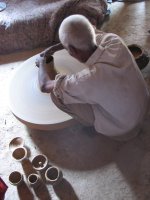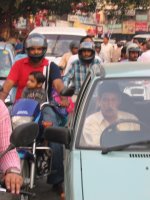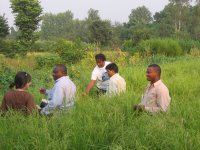
Getting up here to Dharamsala was a trip-- it was my first long trip on a public bus. And by public, I mean unhygenic and over-crowded. on other trips so far, i have taken "tourist buses," which are niether clean nor comfortable (what bus is after 10 hours?) but you have a seat and space for your luggage. the public bus i took from Dehradun to Dharamsala was supposed to be a 13 hour ride. fortunately, i befriended a few tibetan high school students going home for a week vacation. there are tibetan settlements sprinkled around the mountains near Dharamsala. from Dehradun, we drove to Chandigarh, a city about half way there. one the way, i sat between a window and man, who occasionally groped my leg. a young guy got on the bus about half way there and proceeded to open the window next to me, lie across me and my molester friend and wretch out the window. he did the repeatedly over the next 2 hours. from 2AM-5AM, we sat out in the cold in this filthy filthy station that had the stinkiest bathroom i have ever been in, ever. we decided to catch a bus from a different station. to obtain tickets, one had to dive into a writhing crowd around a table (i never saw the center of the table though i assume it was a man with tickets) with arms waving money to purchase seats on the bus. two of the tibetans made their way through and got us seats. then we went to the platform and every time a bus drove up, they ran out to see if it was ours. and we still missed the bus. they put us on another bus but we had lost our seats. so we stood up for the first 3 hours of the 5 hour trip. then we were given the very slightest edge of a seat to perch on. as we ascended the mountains, people kept getting on even though there was no room in the bus in the first place. so at one point, i was sitting with one cheek on the seat, one off, with my knees raming onto a bar in front of me. and there was not another inch to be had. sometimes we'd hit a bump and it would throw everybody out of position given me an opportunity to negotiate another inch. in front of me, i watched a young girl amuse herself by pulling gum out of her mom's mouth, which then stuck to her jacket. she tried to eat it off with little success.

But then we got here and it's ssooooo nice, tucked up here in the mountains. Dharamsala was given to the tibetans because it was undesireable land-- steep land far in the mountains that cannot easily be cultivated. it's much like many of the hill stations built in the mountains, that were summer vacation towns for the british. but it is on a fault and experienced a severe earthquake a while back. and, as i now understand, it's very difficult to reach. the roads are incredibly steep and are poorly maintained (this is a picture of my taxi with bald tires that was unable to climb the mountains without assistance).
 the indian government discriminates against tibet in this respect and such treatment extends to the population as well. my friend from the bus station, Phuntsok, explained that he is planning to go to college in the US because he is tired of such treatment. even at the station, someone asked if he was chinese, in a rude manner.
the indian government discriminates against tibet in this respect and such treatment extends to the population as well. my friend from the bus station, Phuntsok, explained that he is planning to go to college in the US because he is tired of such treatment. even at the station, someone asked if he was chinese, in a rude manner. i feel so fortunate for the experiences i have had with this group of wonderful, peaceful people. if i had not had the assistance of my tibetan friends, i don't think i would've made it out of that filthy station in chandigarh.
I visited the main temple today, where HH gives his teachings.

i cannot really describe these breathtaking places that overtake my senses with the most beautiful, intricate paintings and statues of dieties and bodhisattvas. there is great ritual around these places and they act to preserve the tibetan buddhist culture. there are shelves with small, wrapped packages containing the sutras written in sanskrit, passed down from the buddha. he was an indian prince whose parents were told at birth, that he would be either a great king or spiritual leader. because the king wanted his son to be a king, he sheltered his son and this ultimately caused his son to seek out the truthes of life. i saw one statue i'd never seen before, of the buddha as a skeleton with skin stretch over him and the veins protruding from his body. this is a statue of him after he meditated for five years, waiting for enlightenment.
the walks through the forests in the mountains behind mcleod ganj are amazing. once off the road and away from the exhaust fumes that plague every town-- small and large alike-- the mountain paths are pure tranquility. one led me around the mountain to a village that farms on the steep slops using terraces. sheep and their young grazed on the young green grass. small plots on the terrace below held thriving herb gardens with cilantro. a friendly pup who accompanied on my walk attempted to grab a little sheep's neck and was quickly shooed away by the nearby hearders. From this mountainside I saw some of the most breath taking sunsets of my life.
I also visited the Norbulingka Institute, 












































